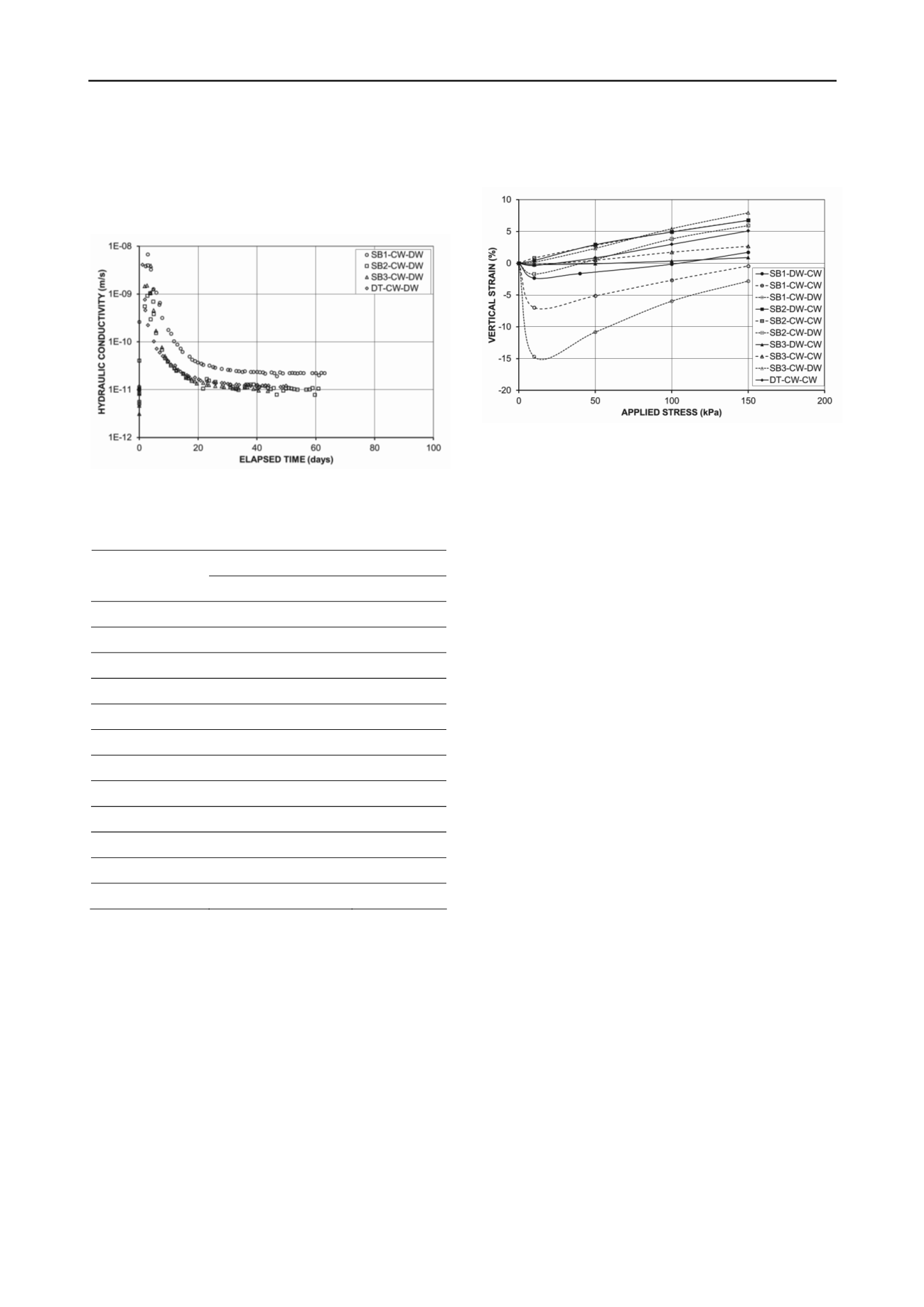
3032
Proceedings of the 18
th
International Conference on Soil Mechanics and Geotechnical Engineering, Paris 2013
higher than, those measured using the compaction mould
permeameter under a 100 kPa applied water pressure, as seen in
Table 3. However, it is important to note that the underlying
flow mechanisms in the compaction mould permeameter and
oedometer tests are quite different.
Figure 7. Hydraulic conductivity of all specimens moisture-conditioned
with CW, compacted, and permeated with DW.
Table 3. Compaction mould permeameter and oedometer hydraulic
onductivities of specimens compacted to 95% of MDD wet of OMC.
c
Hydraulic conductivity under 100 kPa
Sample
Compaction mould
Oedometer
SB1-DW-CW
1.2E-11
3.0E-11
SB1-CW-CW
6.5E-12
7.0E-12
SB1-CW-DW
2.2E-11
1.1E-11
SB2-DW-CW
1.2E-11
1.3E-11
SB2-CW-CW
1.8E-11
1.2E-11
SB2-CW-DW
1.1E-11
7.2E-11
SB3-DW-CW
1.0E-11
1.5E-11
SB3-CW-CW
1.2E-11
1.2E-11
SB3-CW-DW
1.0E-11
1.9E-11
DT-CW-CW
1.1E-11
5.9E-11
DT-CW-DW
1.2E-11
-
Averages
1.2E-11
2.5E-11
In the compaction mould permeameter, ponded water is
forced under a pressure of 100 kPa to flow into the compacted
specimens, causing their moisture content to increase
significantly and the specimens to swell by about 70% of their
initial height, with the upper 3 to 5 mm layer reaching a final
gravimetric moisture content of about 70%. Swelling allowed
the rearrangement of the clay particles from flocculated to
dispersed.
In the oedometer specimens, matric suctions of 40 to 50 kPa
were measured using tensiometers, and swelling pressures were
likely to be greater than 10 kPa. As a result, under an applied
stress of 10 kPa bath water was adsorbed and the compacted
specimens swelled, allowing the rearrangement of the clay
particles. At applied stresses of 50 kPa and greater, water is
forced to flow out of the specimens, as indicated by the
reduction in vertical strain with increasing applied stress shown
in Figure 8. Since the amount of pore water is reducing,
physico-chemical interaction between the pore water and the
clay particles is likely to be limited. The main mechanism is
therefore consolidation, a reduction in the void ratio, and a
consequent reduction in the hydraulic conductivity.
Figure 8. Vertical strains measured during oedometer tests.
5 CONCLUSION
The hydraulic conductivity of clays moisture-conditioned,
compacted and permeated with saline CSG water was found to
be similar to that of the same clays moisture-conditioned,
compacted and permeated with deionised water. The hydraulic
conductivity of the clay specimens decreased with increasing
compaction from 90% to 100% of MDD, achieving a low value
at 100% of MDD. The clays
in situ
would have a high dry
density of at least 100% of their MDD, and hence would be
suitable as a liner for a CSG water storage pond.
In both CSG and deionised waters, the compacted clay
particles dispersed and the hydraulic conductivity decreased to a
very low value of about 1E-11 m/s. The hydraulic conductivities
measured using a compaction mould permeameter were found
to be comparable to, and a little higher than, those calculated
from oedometer test data for the same compacted clays.
6 ACKNOWLEDGEMENTS
The research on which this paper is based was carried out under
an Australian Research Council Linkage Project in
collaboration with QGC Pty Ltd and Golder Associates Pty Ltd.
The assistance of David Truce and Sam Bass of Golder
Associates Brisbane Office in collecting the clay samples, and
undergraduate student Yunpeng Zhang and graduate student
Gwenvael Cochet in assisting with the testing, is gratefully
acknowledged.
7 REFERENCES
Kretzschmar, R., Holthoff, H., and Sticher, H. 1998. Influence of pH
and humic acid on coagulation kinetics of kaolinite: a dynamic light
scattering study.
Journal of Colloid and Interface Science
, 202, 95-
103.
Mitchell, J.K. and Madsen, F.T. 1987. Chemical effects on the clay
hydraulic conductivity. In:
Geotechnical practice for waste disposal
.
ASCE, New York, 87-116.
Richards, L.A. 1954.
Diagnosis and improvement of saline and alkali
soils
. Agriculture Handbook No. 60.
Taylor, D.W. 1942.
Research on consolidation of clays
. 82.
Massachusetts Institute of Technology, Department of Civil
Engineering, Cambridge.
Wang, Y.-H. and Siu, W.-K. 2006. Structure characteristics and
mechanical properties of kaolinite soils. I. Surface charges and
structural characterizations.
Canadian Geotechnical Journal
, 43,
587-600.


